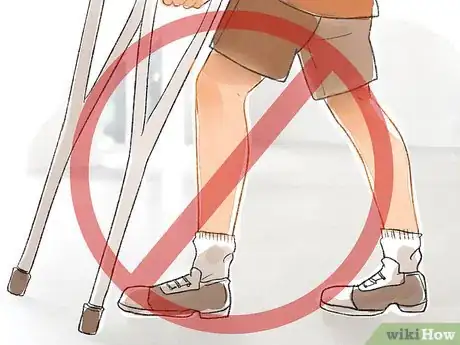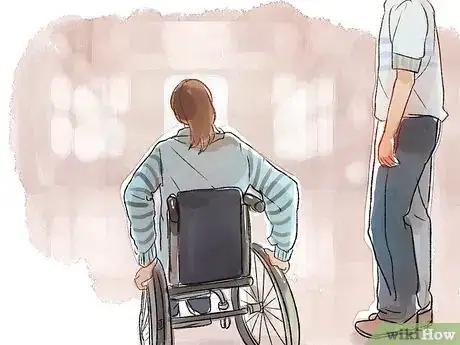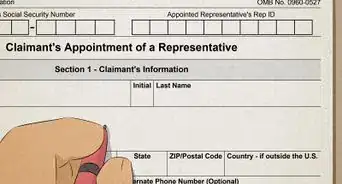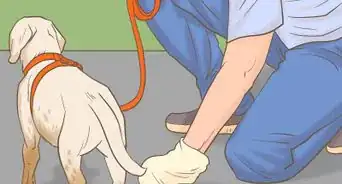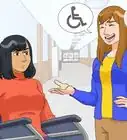This article was co-authored by Trudi Griffin, LPC, MS. Trudi Griffin is a Licensed Professional Counselor in Wisconsin specializing in Addictions and Mental Health. She provides therapy to people who struggle with addictions, mental health, and trauma in community health settings and private practice. She received her MS in Clinical Mental Health Counseling from Marquette University in 2011.
wikiHow marks an article as reader-approved once it receives enough positive feedback. This article received 13 testimonials and 90% of readers who voted found it helpful, earning it our reader-approved status.
This article has been viewed 285,839 times.
It's not uncommon to feel a bit uncertain talking to or interacting with someone who is a physically, or mentally disabled. Socializing with disabled people should be no different from any other socialization. However, if you're not familiar with a particular disability, you might fear either saying something offensive or doing the wrong thing by offering assistance.
Steps
Speaking to Someone who is Disabled
-
1Be respectful, above all else. Someone who is disabled should be afforded the same amount of respect as anyone else. View others as people, not impairments. Focus on the person at hand and their individual personality. If you must put a "label" on the disability, it's best to ask what terminology they prefer and stick with the terms they choose.[1] In general, you should follow the golden rule: treat others as you would like to be treated.[2]
- Most disabled people (75%) prefer "identity first" language,[3] which puts the disability before the word person or people. For example, you would say “his sister Angelica is autistic,” rather than “his sister Angelica is a person with autism.” Most disabled people find that this is more respectful, because person-first language implies they can set their disability aside and pick it back up.
- This isn’t always possible, in which case you could say, "Robert has cerebral palsy," "Leslie has ADHD," or "Sarah uses assistive devices," Take your lead from the person you are interacting with. If they refer to themselves as a person with a disability, ask if they want to be described that way.
- Some groups have specific terminology, like the D(d)eaf/hoh community, where the terms deaf and hard of hearing describe their disability, but the term Deaf (with an uppercase D) to refer to the culture or someone who is part of it.[4] If in doubt, just politely ask the individual you're talking to what they prefer.
-
2Never talk down to someone who is disabled. Regardless of being their abilities, no one wants to be treated like a child or patronized. When you’re speaking to disabled people, don’t use childlike vocabulary, pet names, or a louder-than-average talking voice. Do not use patronizing gestures such as patting them on the back or head. These habits communicate that you don’t think they are capable of understanding you and that you equate them to a child. Use a regular speaking voice and vocabulary, and talk to them just like you would talk to anyone else.
- It is appropriate to slow down your speech for someone who is hard of hearing or has a cognitive disability. Equally, it may be acceptable to talk to people who have hearing loss in a louder than average voice, so that they are able to hear you. Usually, someone will mention it to you if you are speaking too quietly.[5] You may also ask whether you are speaking too quickly, or ask them to tell you if you need to slow down or speak more clearly if necessary.
- Don’t feel like you have to reduce your vocabulary to the most basic words. The only time you may be asked to simplify your language, is if you are talking to someone who has a severe intellectual or communication difficulty. Baffling your conversational partner is unlikely to be viewed as good mannered and neither is talking at somebody who is unable to follow what you are talking about. However, if in doubt, speak casually and ask about their language needs.
Advertisement -
3Don’t use labels or offensive terms, especially in a casual way. Labels and derogatory names are not appropriate and should be avoided in conversation. Assigning a label that is offensive (such as crippled or handicapped) is both hurtful and disrespectful. Always be careful of the things you say, censoring your language if necessary. Avoid names like moron, retard, cripple, spastic, midget, etc., at all times. Be careful not to identify someone by their disability instead of their name or role.
- If you introduce someone, you don’t need to introduce their disability as well. You can say “This is my co-worker, Susan” without saying “This is my co-worker, Susan, who is deaf.” It may be appropriate to say “This is my co-worker, Susan. Please face her when you’re talking to her.” But this is on a case-by-case basis. You can always offer to make sure people will be mindful of their needs, but you shouldn’t do so without asking first.
- If you use a common phrase like “I gotta run!” to someone in a wheelchair, don’t apologize. These types of phrases are not intended to be hurtful, and by apologizing you’ll simply be drawing attention to your awareness of their disability.[6]
-
4Speak directly to the person, not to an aide or translator. It’s frustrating for disabled people to have to deal with people never talking directly to them if they have an assistant or a translator present. Equally, talk to a person in a wheelchair, rather than the person standing next to them.[7] If you’re speaking with someone who has a nurse to help or someone who is deaf and has a sign language interpreter, you should still always speak directly to them.
- Even if the person doesn't have typical listening body language (e.g. an autistic person who doesn't look at you), don't assume that they can't hear you. Speak to them.
-
5Be patient and ask questions, if necessary. It can be tempting to speed along a conversation or to finish their sentences, but doing so can be disrespectful.[8] Always let them speak and work at their own pace, without you egging them to talk, think, or move faster. Additionally, if you don’t understand something someone says because they’re speaking too slowly or too quickly, don’t be afraid to ask questions. Assuming you know what someone said can be detrimental and embarrassing if you mishear them, so always double-check.
- Someone with a speech impediment might be particularly difficult to understand, so don’t rush them to talk faster and ask them to repeat themselves if necessary.
- Some people need extra time to process speech or turn their thoughts into spoken words (regardless of intellectual ability). It's okay if there are long pauses in the conversation.
-
6Don't be afraid of asking about a person’s disability. It may not be appropriate to ask about someone’s disability out of curiosity, but if you feel this might help you make a situation easier for them (like asking a person if they would prefer to take the elevator with you instead of the stairs if you see they have trouble walking), it is appropriate to ask questions.[9] Chances are, they have been asked about their disability repeatedly over their life and know how to explain it in a few sentences. If the disability resulted from an accident or the person finds the information too personal, they will most likely answer that they prefer not to discuss it.
- Assuming you know what their disability is can be offensive; it is better to ask than to presume knowledge.[10]
-
7Recognize that some disabilities are not visible. If you see someone who appears able-bodied parking in a handicapped spot, don't confront them and accuse them of lacking a disability; they may have a disability you cannot see. Sometimes called "invisible disabilities," disabilities that cannot be immediately seen are still disabilities.[11]
- A good habit to be in is to act kindly and considerately towards everyone; you can't know someone's situation by just looking at them.
- Some disabilities vary from day to day: someone who needed a wheelchair yesterday might only need a cane today. This doesn't mean they're faking it or "getting better," just that they have good days and bad days like everyone else. A large percentage of wheelchair users are what’s called “ambulatory wheelchair users,” meaning they can walk or stand, but it is dangerous or painful for them to do so. A wheelchair is not limiting, it allows them greater access. By the same token, most blind people have some remaining vision. If they say they like your shirt color, don’t say “how can you see it?” Just say thank you, and move on.
- Avoid expressing sympathy for their disability. Don’t say “this is so beautiful, I wish you could see it.” Instead you can say “the sunset is really pretty right now, do you want me to describe it?”
Interacting Appropriately
-
1Put yourself in their place. It may be easier to understand how to interact with disabled people if you imagine being disabled yourself. Think about how you would want people to talk to or treat you. It’s likely that you wanted to be treated just as you are now.
- Therefore, you should talk to disabled people as you would anyone else. Welcome a disabled coworker as you would anyone else new to your workplace. Never stare or act condescending or patronizing.
- Don't focus on their disability. It is not important that you figure out the nature of someone’s disability. It is only important that you treat them equally, talk to them as you would to anyone else, and act as you would normally act if a new person entered into your life.
-
2Offer genuine help. Some people are hesitant to offer to help disabled people for fear of offending them. Indeed, if you are offering help because of an assumption that someone cannot do something themselves, your offer could be offensive. However, very few people would be offended by a genuine, specific offer of assistance.
- Many disabled people are hesitant to ask for help, but may be grateful for an offer.
- For example, if you go shopping with a friend who uses a wheelchair, you could ask if they need assistance carrying their bags or attaching them to their wheelchair. Offering to help a friend is not usually offensive.
- If you are not sure of a specific way to help, you can ask, “Is there anything that I can do to help you right now?”
- Never 'help' someone without asking first; for example, do not grab someone’s wheelchair and try to push them up a steep ramp. You wouldn’t want someone to start moving your legs for you. Instead, ask if they need a push or if you can do anything else to make it easier for them to navigate the terrain.[12]
-
3Ignore service animals. Service animals may be cute and well trained, making them perfect candidates for cuddling and play time. However, they are used for helping the person with the disability, and are necessary for performing common tasks. If you take time to play with the animal without asking permission, you may be distracting the animal from an important task it needs to perform for its owner. If you see a service animal in action, you should not distract it by petting it. If the animal is not doing any tasks, you can ask the owner permission to pet it or play with it. Keep in mind though that you may be turned down, in which case you should not be upset or disappointed.
- Don’t give a service animal food or treats of any kind without permission.
- Don’t try to distract a service animal by calling it pet names, even if you don’t actually pet or touch it.
-
4Avoid playing with someone’s wheelchair or walking device. A wheelchair might seem like a good place to rest your arm, but doing so can be uncomfortable or annoying to the person sitting in it. Unless you’re asked to help someone by pushing or moving their wheelchair, you should never touch or play with it. The same advice goes for walkers, scooters, crutches, or any other device someone might be using for everyday functioning. If you ever feel the need to move someone’s wheelchair, you should ask permission first, and wait for their response. Do not ask to play with someone's wheelchair, as it is a childish question and it may make the person feel uncomfortable.
- Treat disability equipment like extensions of their body: you wouldn't grab and move someone's hand or decide to lean up against their shoulder. Behave the same way towards their equipment.
- Any tool or device a person might use to help with their disability, such as a hand-held translator or an oxygen tank, should never be touched unless you are directed to do so.
-
5Acknowledge that most disabled people have adapted. Some disabilities are present from birth, and others come later in life due to development, accident, or illness. However the disability developed, most people learn how to adapt and take care of themselves independently. Most are independent in everyday living, requiring little help from others.[13] As a result, it can be offensive or annoying to assume that someone with a disability cannot do many things, or to constantly try to do things for them. If you help a lot of the time and in a childish voice, this may be annoying. Work under the assumption that the person can accomplish whatever task is at hand by themselves.
- A person who becomes disabled as a result of an accident later in life may require more help than someone with a lifelong disability, but you should always wait until they ask for your help before assuming they need it.
- Don’t avoid asking someone who’s disabled to do a certain task because you worry they can’t accomplish it.
- If you do offer help, make the offer genuine and specific. If you are offering from a place of genuine kindness, and not an assumption that the person cannot do something, you’re less likely to offend.
-
6Avoid getting in the way. Try to be courteous around people with physical disabilities by staying out of the way. Move to the side if you see someone attempting to navigate in a wheelchair. Move your feet out of the path of someone who is using a cane or a walker. If you notice that someone does not seem to be strong and steady on their feet, offer help verbally. Don't invade someone’s personal space, just as you would not invade anyone else's. However, if someone asks you for assistance, be prepared to give it.
- Do not touch anyone’s equipment or animal without asking. Remember that a wheelchair or other aid is personal space; it's part of the person. Please respect that.
Warnings
- Only offer help if you are physically able to perform the task. If you know you cannot lift a baby-carriage or walker onto a bus or provide a secure hold for a person stepping off the train or bus, tell the driver or the other people on the bus that help is needed, or offer the person in need of help the use of a cellphone to call someone. Don't ignore the situation because you feel incapable of helping yourself.⧼thumbs_response⧽
References
- ↑ http://uiaccess.com/accessucd/interact.html
- ↑ http://www.dhs.state.il.us/page.aspx?item=32276
- ↑ http://autisticadvocacy.org/identity-first-language/
- ↑ http://nad.org/issues/american-sign-language/community-and-culture-faq
- ↑ http://www.dhs.state.il.us/page.aspx?item=32276
- ↑ http://www.dhs.state.il.us/page.aspx?item=32276
- ↑ http://uiaccess.com/accessucd/interact.html
- ↑ http://www.dhs.state.il.us/page.aspx?item=32276
- ↑ http://uiaccess.com/accessucd/interact.html
About This Article
To interact with people who have disabilities, speak to them as you would anyone else. Don't slow down your speech or use simpler vocabulary, unless you're talking to someone who's hearing or cognitively impaired. Additionally, be respectful by fully listening to them when they’re speaking and not rushing them or finishing their sentences. Moreover, try not to brush past their answers, or assume that you know what's best. Instead, respectfully ask questions, like if taking the elevator would be easier than taking the stairs. To learn how to avoid getting in the way of a person with a disability, keep reading!










